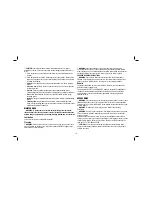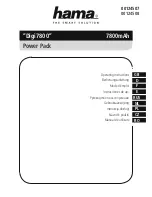
9
FUEL GAUGE BATTERY PACKS (FIG.4)
Some D
E
WALT battery packs include a fuel gauge which consists of three green LED
lights that indicate the level of charge remaining in the battery pack.
To actuate the fuel gauge, press and hold the fuel gauge button (I). A combination of
the three green LED lights will illuminate designating the level of charge left. When
the level of charge in the battery is below the usable limit, the fuel gauge will not
illuminate and the battery will need to be recharged.
NOTE:
The fuel gauge is only an indication of the charge left on the battery pack.
It does not indicate tool functionality and is subject to variation based on product
components, temperature and end-user application.
For more information regarding fuel gauge battery packs, please call
1800 444 224
(Aust) or 0800 339 258 (NZ) or visit our website www.dewalt.com.au or www.
dewalt.com.nz.
Variable Speed Trigger Switch (Fig. 2)
To turn the tool on, squeeze the trigger switch (A). To turn the tool off, release the
trigger switch. Your tool is equipped with a brake. The anvil will stop when the trigger
switch is fully released. The variable speed switch enables you to select the best
speed for a particular application. The more you squeeze the trigger, the faster the
tool will operate. For maximum tool life, use variable speed only for starting holes or
fasteners.
NOTE:
Continuous use in variable speed range is not recommended. It may damage
the switch and should be avoided.
Forward/Reverse Control Button (Fig. 2)
A forward/reverse control button (B) determines the direction of the tool and also
serves as a lock-off button.
To select forward rotation, release the trigger switch and depress the forward/reverse
control button on the right side of the tool.
To select reverse, release the trigger switch and depress the forward/reverse control
button on the left side of the tool.
The center position of the control button locks the tool in the OFF position. When
changing the position of the control button, be sure the trigger is released.
NOTE:
The first time the tool is run after changing the direction of rotation, you may
hear a click on start up. This is normal and does not indicate a problem.
Worklight (Fig. 2)
There is a worklight (G) located above the trigger switch (A). The worklight is
activated when the trigger switch is depressed. When the trigger is released, the
worklight will stay illuminated for up to 20 seconds.
NOTE:
The worklight is for lighting the immediate work surface and is not intended to
be used as a flashlight.
Proper Hand Position (Fig. 5)
FIG. 5
WARNING:
To reduce the risk of
serious personal injury, Always use
proper hand position as shown.
WARNING:
To reduce the risk of
serious personal injury, always hold
securely in anticipation of a sudden
reaction.
Proper hand position requires one hand
on the main handle (D).
Anvil (Fig. 6)
WARNING:
Use only impact accessories. Non-impact
FIG. 6
H
C
accessories may break and cause a hazardous condition.
Inspect accessories prior to use to ensure that it con tains
no cracks.
Place the switch in the locked off (center) position or
remove battery pack before changing accessories.
CAUTION:
Inspect anvils and detent pins prior to use.
Missing or damaged items should be replaced before use.
ANVIL WITH DETENT PIN (FIG. 6)
To install an accessory on the anvil,
align the hole in the
side of the accessory with the detent pin (H) on the anvil
(C). Press the accessory on until the detent pin engages in the hole. Depression of
detent pin may be necessary to aid installation of accessory.
To remove an accessory,
depress the detent pin through the hole and pull the
accessory off.
Summary of Contents for DCF889-XE
Page 1: ...DCF889 XE 18 V CORDLESS 13 mm 1 2 CORDLESS IMPACT WRENCH INSTRUCTION MANUAL ...
Page 2: ......
Page 13: ......
Page 14: ......
Page 15: ......


































